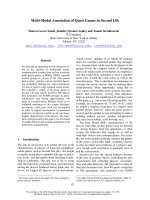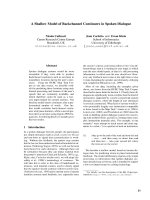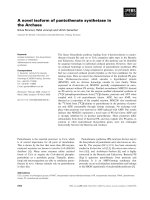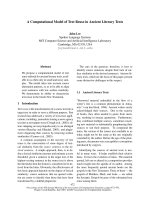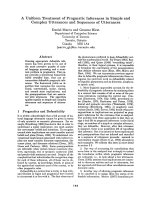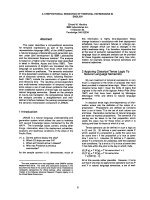Báo cáo khoa học: " The prognostic value of nestin expression in newly diagnosed glioblastoma: Report from the Radiation Therapy Oncology Group" potx
Bạn đang xem bản rút gọn của tài liệu. Xem và tải ngay bản đầy đủ của tài liệu tại đây (331 KB, 8 trang )
BioMed Central
Page 1 of 8
(page number not for citation purposes)
Radiation Oncology
Open Access
Research
The prognostic value of nestin expression in newly diagnosed
glioblastoma: Report from the Radiation Therapy Oncology Group
Prakash Chinnaiyan*
1
, Meihua Wang
2
, Amyn M Rojiani
3
, Philip J Tofilon
4
,
Arnab Chakravarti
5
, K Kian Ang
6
, Hua-Zhong Zhang
6
, Elizabeth Hammond
7
,
Walter Curran Jr
8
and Minesh P Mehta
9
Address:
1
Department of Radiation Oncology, H. Lee Moffitt Cancer Center and Research Institute, Tampa, USA,
2
Department of Statistics,
American College of Radiology, Philadelphia, USA,
3
Department of Pathology, H. Lee Moffitt Cancer Center and Research Institute, Tampa, USA,
4
Department of Drug Discovery, H. Lee Moffitt Cancer Center and Research Institute, Tampa, USA,
5
Department of Radiation Oncology,
Massachusetts General Hospital/Harvard Medical School, Boston, USA,
6
Department of Radiation Oncology, MD Anderson Cancer Center,
Houston, USA,
7
Department of Pathology, LDS Hospital, Salt Lake City, USA,
8
Department of Radiation Oncology Emory University, Atlanta, USA
and
9
Department of Human Oncology, University of Wisconsin Hospitals, Madison, USA
Email: Prakash Chinnaiyan* - ; Meihua Wang - ;
Amyn M Rojiani - ; Philip J Tofilon - ;
Arnab Chakravarti - ; K Kian Ang - ; Hua-
Zhong Zhang - ; Elizabeth Hammond - ;
Walter Curran - ; Minesh P Mehta -
* Corresponding author
Abstract
Background: Nestin is an intermediate filament protein that has been implicated in early stages of
neuronal lineage commitment. Based on the heterogeneous expression of nestin in GBM and its potential
to serve as a marker for a dedifferentiated, and perhaps more aggressive phenotype, the Radiation Therapy
Oncology Group (RTOG) sought to determine the prognostic value of nestin expression in newly
diagnosed GBM patients treated on prior prospective RTOG clinical trials.
Methods: Tissue microarrays were prepared from 156 patients enrolled in these trials. These specimens
were stained using a mouse monoclonal antibody specific for nestin and expression was measured by
computerized quantitative image analysis using the Ariol SL-50 system. The parameters measured included
both staining intensity and the relative area of expression within a specimen. This resulted into 3
categories: low, intermediate, and high nestin expression, which was then correlated with clinical outcome.
Results: A total of 153 of the 156 samples were evaluable for this study. There were no statistically
significant differences between pretreatment patient characteristics and nestin expression. There was no
statistically significant difference in either overall survival or progression-free survival (PFS) demonstrated,
although a trend in decreased PFS was observed with high nestin expression (p = 0.06).
Conclusion: Although the correlation of nestin expression and histologic grade in glioma is of
considerable interest, the presented data does not support its prognostic value in newly diagnosed GBM.
Further studies evaluating nestin expression may be more informative when studied in lower grade glioma,
in the context of markers more specific to tumor stem cells, and using more recent specimens from
patients treated with temozolomide in conjunction with radiation.
Published: 25 September 2008
Radiation Oncology 2008, 3:32 doi:10.1186/1748-717X-3-32
Received: 6 June 2008
Accepted: 25 September 2008
This article is available from: />© 2008 Chinnaiyan et al; licensee BioMed Central Ltd.
This is an Open Access article distributed under the terms of the Creative Commons Attribution License ( />),
which permits unrestricted use, distribution, and reproduction in any medium, provided the original work is properly cited.
Radiation Oncology 2008, 3:32 />Page 2 of 8
(page number not for citation purposes)
Background
Nestin is an intermediate filament protein that was ini-
tially identified during studies involving cellular organiza-
tion of the developing rat nervous system [1]. It was
described as the antigen to the monoclonal antibody Rat-
401 that specifically identified transient radial glial cells,
which guided neuronal migration. It was later cloned in
humans and its gene product defined a distinct sixth class
of intermediate filament proteins [2]. Nestin expression
has been demonstrated in neuroepithelial stem cells and
progenitor cells in the human brain and implicated in
early stages of lineage commitment. Further, as these pre-
cursor cells differentiate along their respective neural or
glial cell types, nestin expression has been shown to be
down regulated [2-4].
Although not a definitive neural stem cell marker [5], nes-
tin is expressed in the minor-population of tumor stem
cells derived from brain tumors that have recently been
shown to contribute towards tumorigenicity [5] and ther-
apeutic resistance [6] in glioblastoma (GBM). Although
very little is known about the function of nestin, it has
been implicated in the distribution and organization of
critical cellular factors regulating cell proliferation, sur-
vival, and differentiation [7-10]. In addition, nestin has
been shown to act as a scaffold protein that regulates the
activities of kinases, therefore a potential organizer of sur-
vival-determining signaling molecules [9]. However,
whether nestin expression is merely a marker of a dediffer-
entiated state or has a specific biologic function in GBM,
remains unclear.
Dalhstrand et al [11] and Tohymama et al [12] performed
initial investigations that identified diffuse nestin expres-
sion in glioma. Interestingly, these early studies identified
higher levels of nestin expression in GBM than in lower
grade gliomas [11], supporting its potential application as
a marker for dedifferentiation in glioma. Despite the gen-
eral increased expression of nestin in GBM, staining pat-
terns are heterogeneous, with a proportion of GBM
samples demonstrating little to no expression of nestin
[11,13-17]. The clinical relevance of these varying expres-
sion patterns of nestin in GBM has not been defined.
Based on the heterogeneous expression of nestin in GBM
and its potential to serve as a marker for a dedifferenti-
ated, and perhaps more aggressive phenotype, the RTOG
sought to determine the prognostic value of nestin expres-
sion in newly diagnosed GBM patients treated on prior
prospective RTOG clinical trials.
Methods
Study population
Table 1 lists the specific RTOG trials represented in this
correlative study (RTOG 7401, 7918, 8302, 8409, 9006,
9305, 9602, 9806). Patients were generally treated by sur-
gical resection, followed by external beam radiotherapy
with or without chemotherapy. The specific chemothera-
peutic and other experimental interventions in these trials
did not appear to influence survival times. Table 2
presents the relevant demographic data of the 153
patients with GBM treated on previous RTOG clinical tri-
als who had tissue blocks adequate to generate tissue
microarrays (TMAs) for the present analysis. TMAs were
prepared and evaluated as previously described [18].
Nestin immunohistochemical staining
Tissue microarrays were processed using a Ventana Dis-
covery XT automated system (Ventana Medical Systems,
Tucson) as per manufacturer's protocol with proprietary
reagents. Briefly, slides were deparaffinized on the auto-
mated system with EZ Prep solution (Ventana). Heat-
induced antigen retrieval method was used in Cell Condi-
tioning solution (CC1, Ventana). The mouse monoclonal
antibody that reacts to nestin (ab22035, abcam) was used
at a 1:900 concentration in Dako antibody diluent and
incubated for 60 min. The Ventana Universal Secondary
Antibody was used for 32 min at 37°C. The detection sys-
tem used was the Ventana DABMap kit and slides were
then counterstained with Hematoxylin. Slides were then
dehydrated and coverslipped as per normal laboratory
protocol.
Quantification of nestin expression
Slides were bar-coded and blinded for automated slide
scan imaging and processing. The Ariol SL-50 (version
3.1.2) from Applied Imaging is an automated slide scan-
Table 1: RTOG studies included in analysis
Study Phase Description N = 153
7401 III WBRT+(BCNU vs. MeCCNU+DTIC) 38 (25%)
7918 III WBRT+(BCNU vs. Misonidazole radiosensitizer & BCNU) 9 (6%)
8302 III Hyperfractionated and Accelerated RT + BCNU 30 (20%)
8409 I/II WBRT + AZQ (NSC-182986) 1 (1%)
9006 III BCNU + (Hyperfractionated RT vs. RT) 32 (21%)
9305 III +/-SRS followed by RT+BCNU 3 (2%)
9602 II RT + Taxol 13 (8%)
9806 II RT + Thalidomide 27 (18%)
Radiation Oncology 2008, 3:32 />Page 3 of 8
(page number not for citation purposes)
ner capable of high-throughput slide analysis designed for
accuracy, repeatability and objectivity. The system's built
in classifiers include the analysis capability for nuclear,
cytoplasmic and membranous event classification with
trainable software. It uses an Olympus BX-61 upright
microscope to provide high-quality images at 1.25×, 5×,
10×, 20× and 40× objectives.
Detailed images were processed using the TMA Multistain
Imaging Module for the nestin stained brain tissue micro-
arrays slides. The TMAs were processed using the TMA spe-
cific imaging assay, TMA Multistain. This allows the
software to distinguish positive tumor areas within indi-
vidual cores of the TMA slide. Both staining intensity and
its relative area within a specimen were quantified. Stain-
ing intensity was acquired in a continuous gradient and
divided into tertiles defined as negative (0), lightly posi-
tive (1+), moderately positive (2+) and highly positive
(3+) regions. The area occupied by each of these 4 catego-
ries was determined, and divided into similar tertiles. A
score of 3, 2, 1, and 0 was designated to relative areas ≥
50%, 33–49%, 1–33%, and 0%, respectively, within the
evaluated area of the specimen. This allowed the software
to automatically quantitate not only the average intensity
of each category, but also the relative area of these stains.
The products of the scoring system described above (rela-
tive intensity × area) yielded values ranging from 0 to 9,
with higher scores reflecting more quantified nestin
expression. The highest score of the individual products
was used for analysis. Low, intermediate, and high expres-
sion was defined as scores ranging from 0–3, 4–6, and 7–
9, respectively. Representative samples for low, intermedi-
ate, and high expression are shown in Figure 1. All speci-
mens were manually reviewed by a neuropathologist
(AMR) to verify overall quality of staining of the tissue
microarray and ensure appropriate evaluation of tumor
tissue versus necrosis, vessels, and/or other potential aber-
rances in individual specimens.
Statistical analysis
This analysis included 153 evaluable patients from 8
RTOG GBM studies. Frequency distributions for the
Table 2: Patient characteristics by study
Characteristics 7401
(n = 38)
7918
(n = 9)
8302
(n = 30)
8409
(n = 1)
9006
(n = 32)
9305
(n = 3)
9602
(n = 13)
9806
(n = 27)
Total
(N = 153)
Gender
Male 27 (71%) 4 (44%) 22 (73%) 1 (100%) 20 (63%) 1 (33%) 5 (38%) 18 (67%) 98 (64%)
Female 11 (29%) 5 (56%) 8 (27%) 0 12 (38%) 2 (67%) 8 (62%) 9 (33%) 55 (36%)
Race
White 35 (92%) 8 (89%) 28 (93%) 1 (100%) 30 (94%) 3 (100%) 13(100%) 26 (96%) 144 (94%)
Hispanic 2 (5%) 0 0 0 0 0 0 1 (4%) 3 (2%)
Black 1 (3%) 1 (11%) 1 (3%) 0 2 (6%) 0 0 0 5 (3%)
Other 0 0 1 (3%) 0 0 0 0 0 1 (1%)
Neuro. Function (Symptoms)
None/Minor 16 (42%) 3 (33%) 13 (43%) 0 23 (72%) 0 7 (54%) 19 (70%) 84 (54%)
Moderate 13 (34%) 5 (56%) 16 (53%) 1 (100%) 9 (28%) 3 (100%) 6 (46%) 8 (30%) 59 (38%)
Major/Severe 8 (21%) 1 (11%) 1 (3%) 0 0 0 0 0 11 (7%)
Missing 1 (3%) 0 0 0 0 0 0 0 1 (1%)
KPS
≤ 60 11 (29%) 1 (11%) 2 (7%) 0 1 (3%) 0 0 2 (7%) 17 (11%)
70–80 13 (34%) 6 (67%) 19 (63%) 1 (100%) 12 (38%) 0 6 (46%) 10 (37%) 67 (44%)
90–100 14 (37%) 2 (22%) 9 (30%) 0 19 (59%) 3 (100%) 7 (54%) 15 (56%) 69 (45%)
Prior Surgery
Biopsy 5 (13%) 0 1 (3%) 0 1 (3%) 0 0 3 (11%) 10 (7%)
Part. Resect. 21 (55%) 5 (56%) 22 (73%) 1 (100%) 15 (47%) 1 (33%) 10 (77%) 15 (56%) 90 (59%)
Tot. Resect. 11 (29%) 4 (44%) 7 (23%) 0 16 (50%) 2 (67%) 3 (23%) 8 (30%) 51 (33%)
Unknown 1 (3%) 0 0 0 0 0 0 1 (4%) 2 (1%)
RPA
III 6 (16%) 1 (11%) 3 (10%) 0 7 (22%) 2 (67%) 4 (31%) 6 (22%) 29 (19%)
IV 15 (39%) 3 (33%) 13 (43%) 1 (100%) 16 (50%) 1 (33%) 3 (23%) 11 (41%) 63 (41%)
V 17 (45%) 5 (56%) 14 (47%) 0 9 (28%) 0 6 (46%) 10 (37%) 61 (40%)
Radiation Oncology 2008, 3:32 />Page 4 of 8
(page number not for citation purposes)
patient characteristics in the three nestin expression levels
were compared using χ
2
tests of homogeneity. Kaplan-
Meier method was used to estimate the OS and the PFS
rates and the log-rank test to compare them between the
three patient groups. An event for OS is death due to any
cause. An event for PFS is recurrence, progression, or
death. The Cox proportional hazards model was used to
estimate the hazard ratio (HR) associated with each end-
point. A two-sided test was used at a significance level
0.05 for testing.
Results
The original RTOG TMA consisted of 156 GBM patients,
of which, 153 were evaluable. Of these, the total number
of patients that comprised the low, intermediate, and high
expression groups were 17, 70, and 66 patients, respec-
tively. The pretreatment characteristics of patients in these
three groups appear in Table 3. There were no statistically
significant differences seen between the three groups,
although there is a trend towards more of the patients
with intermediate nestin expression level in RPA III (p =
0.08). When the three groups were compared with regards
to OS and PFS based on the log-rank test, no differences
were seen at the significance level of 0.05 (Table 4 and 5).
Corresponding Kaplan-Meier survival curves are shown in
Figures 2, 3. The 12-month survival rates for the patients
with low, intermediate, and high nestin expression were
59%, 49%, and 48% respectively. The 12-month PFS rates
for the patients with low, intermediate, and high nestin
expression were 29%, 27%, and 23% respectively.
Tables 6 and 7 presents the OS and PFS results based on
the Cox proportional hazard model. No difference was
found in OS with nestin expression level [intermediate vs.
low: HR = 1.66 (0.94, 2.93), p = 0.98; high vs. low: HR =
1.47 (0.83, 2.60), p = 0.18], even after adjusting for RPA
class [IV vs. III: HR = 1.65 (1.03, 2.66), p = 0.04; V vs. III:
HR = 2.58 (1.60, 4.15), p < 0.0001]. The global test for the
interaction of nestin expression level and RPA class was
not statistically significant (P < 0.001). No difference was
found in PFS with nestin expression level [intermediate
vs. low: HR = 1.47 (0.84, 2.59), p = 0.18; high vs. low: HR
= 1.73 (0.98, 3.06), p = 0.06] without including RPA class,
which was not statistically significant.
Discussion
Although initially identified in glioma, nestin expression
has since been demonstrated in several other malignan-
cies, including angiosarcoma, gastrointestinal stromal
tumors (GIST) [19], hemangioblastomas [20], melanoma
[21,22], and basal epithelial breast cancer [23]. Interest-
ingly, in many of these tumors, including glioma, nestin
expression has been shown to correlate with advanced
grade [11,13-17,19,23,24], supporting its application as a
marker for dedifferentiation. As these dedifferentiated or
progenitor cells have been implicated in both tumorigen-
esis [5] and therapeutic resistance [6], we sought to deter-
mine if nestin expression level could be used as a clinically
relevant prognosticator in GBM.
The presented data evaluates the prognostic impact of nes-
tin expression in GBM. Other investigators have suggested
a more definitive correlation of nestin expression with
decreased overall survival [14,17], although these studies
included all high-grade glioma. With the known correla-
tion of increased nestin expression with higher-grade gli-
oma, coupled with the known prognostic value of tumor
grade alone in glioma, it is unclear if nestin expression
would retain its prognostic value in these studies if tumor
grade was considered independently.
Varying levels of nestin expression in GBMFigure 1
Varying levels of nestin expression in GBM. Images are representative of samples categorized as low (A), intermediate
(B), and high (C) nestin expression.
Radiation Oncology 2008, 3:32 />Page 5 of 8
(page number not for citation purposes)
Based on the presented findings, total nestin expression
level, as measured immunohistochemically, does not
appear to demonstrate a statistically significant difference
in OS or PFS in newly diagnosed GBM. However, there are
potential limitations to the interpretation of these results.
As the tissue microarray used in this study was created ret-
rospectively from all available tissue from the respective
trials, one could make the valid argument that this popu-
lation would be enriched with patients undergoing a com-
plete or partial resection versus biopsy alone, and
therefore this cohort may not be an appropriate represen-
tation of all GBM. Secondly, the archived tissue spans over
20 years from patients enrolled on a variety of different
therapeutic regimens, although clinical outcome did not
appear to be altered. And lastly, and perhaps the most
important, these findings are only relevant to the pre-
temozolomide era. As the standard of care has since
shifted, it would be of value to revisit these studies in this
context. Along these lines, defining the relationship of
nestin expression with the promoter methylation status of
MGMT would also be of considerable value [25,26].
In addition, studies focused on nestin expression in low-
grade glioma may also have more definitive clinical appli-
Table 3: Patient characteristics
Characteristics Low (n = 17) Intermediate (n = 70) High (n = 66) p-value*
Gender 0.17
Male 13 (76%) 48 (69%) 37 (56%)
Female 4 (24%) 22 (31%) 29 (44%)
Race 0.88
White 15 (88%) 66 (94%) 63 (95%)
Hispanic 1 (6%) 1 (1%) 1 (2%)
Black 1 (6%) 2 (3%) 2 (3%)
Other 0 1 (1%) 0
Neurologcal Function (Symptoms) 0.69
None/Minor 7 (41%) 40 (57%) 37 (56%)
Moderate 8 (47%) 25 (36%) 25 (38%)
Major/Severe 2 (12%) 5 (7%) 3 (5%)
Missing 0 0 1 (1%)
KPS 0.41
≤ 60 4 (24%) 7 (10%) 6 (9%)
70–80 8 (47%) 29 (41%) 30 (45%)
90–100 5 (29%) 34 (49%) 30 (45%)
Prior Surgery 0.84
Biopsy 0 5 (7%) 5 (8%)
Partial Resection 11 (65%) 42 (60%) 37 (56%)
Total Resection 6 (35%) 22 (31%) 23 (35%)
Unknown 0 1 (1%) 1 (1%)
RPA 0.08
III 3 (18%) 20 (28%) 6 (9%)
IV 7 (41%) 25 (36%) 31 (47%)
V 7 (41%) 25 (36%) 29 (44%)
Study
7401 6 (35%) 22 (31%) 10 (15%)
7918 3 (18%) 4 (6%) 2 (3%)
8302 4 (23%) 16 (23%) 10 (15%)
8409 0 1 (1%) 0
9006 1 (6%) 13 (19%) 18 (27%)
9305 1 (6%) 1 (1%) 1 (1%)
9602 2 (12%) 3 (4%) 8 (12%)
9806 0 10 (14%) 17 (26%)
* Chi-square Tests
Radiation Oncology 2008, 3:32 />Page 6 of 8
(page number not for citation purposes)
Kaplan-meier estimates of progression-free survival accord-ing to level of nestin expressionFigure 3
Kaplan-meier estimates of progression-free survival
according to level of nestin expression. Nestin expres-
sion, stratified as low, intermediate, or high expression,
appears to have no statistically significant relationship with
progression-free survival.
Table 4: Overall survival
Low Intermediate High
Months % Alive No. at Risk % Alive No. at Risk % Alive No. at Risk
0 100%17100%70100%66
12 59% 10 49% 34 48% 32
24 29% 5 16% 11 12% 8
36 18% 3 5% 3 5% 3
48 12% 1 0 0 2% 1
60 12% 1 0 0 2% 1
Median Dead/Total 13.3 mo. 16/17 11.8 mo. 69/70 11.6 mo. 65/66
Pairwise Comparisons using Log-rank test: Low vs. Intermediate (0.18), Low vs. High (0.16), Intermediate vs. High (0.80).
Table 5: Progression-free survival
Low Intermediate High
Months % Alive No. at Risk % Alive No. at Risk % Alive No. at Risk
0 100%17100%70100%66
12 29% 5 27% 19 23% 15
24 12% 2 11% 8 6% 4
36 12% 2 4% 2 0 0
48 12%10000
60 12%10000
Median Dead/Total 9.9 mo. 16/17 7.2 mo. 69/70 5.8 mo. 66/66
Pairwise Comparisons using Log-rank test: Low vs. Intermediate (0.2), Low vs. High (0.08), Intermediate vs. High (0.31).
Kaplan-meier estimates of overall survival according to level of nestin expressionFigure 2
Kaplan-meier estimates of overall survival according
to level of nestin expression. Nestin expression, stratified
as low, intermediate, or high expression, appears to have no
statistically significant relationship with overall survival.
Radiation Oncology 2008, 3:32 />Page 7 of 8
(page number not for citation purposes)
cations. Our data (not included) as well as others [11,14-
17,24], have shown in low-grade glioma, despite a higher
proportion of tumors demonstrating low nestin expres-
sion, a significant number of these specimens do express
nestin highly. With the significantly more heterogeneous
clinical outcomes in low-grade glioma, defining the prog-
nostic value of nestin in this population would be of par-
ticular interest. For example, in this context, nestin
expression may potentially serve as a biologic marker for
a high-risk low-grade glioma, which could have a direct
clinical application.
Conclusion
Although the correlation of nestin expression and histo-
logic grade in glioma is of considerable interest, the pre-
sented results do not support its influence on prognosis in
GBM patients. Nestin appears to define a dedifferentiated
state, although is not a definitive neural stem cell marker
[5]. Therefore, nestin expression may have a limited role
in identifying the specific cancer stem cell populations
within a tumor. This is further supported by the diffuse
staining of nestin in our specimens, as opposed to cancer
stem cells, which purportedly represent only a minor-frac-
tion of the entire brain tumor cell population. Therefore,
further studies evaluating nestin expression in GBM may
be more informative when studied in the context of mark-
ers more specific to tumor stem cells, including CD133
[5]. In addition, future investigations evaluating more
recent specimens from patients treated during the temo-
zolomide era in conjunction with MGMT promoter meth-
ylation status may have a more direct clinical relevance.
Competing interests
The authors declare that they have no competing interests.
Authors' contributions
PC and AMR manually reviewed all histological sections.
PC, MW, and PJT were involved in the initial research con-
cept and draft. MW performed all statistical analysis. AC,
KKA, HZ, EH, WC, and MPM were involved in creation of
TMAs used in this study. All authors read and approved
the final manuscript
Acknowledgements
This project was supported (in part) by the American Cancer Society's
Institutional Research Grant #93-032-13 (P.C.) and the Analytic Micros-
copy Core Facility at the H. Lee Moffitt Cancer Center. We would also like
to thank Noel Clark for his assistance with immunohistochemical staining.
References
1. Hockfield S, McKay RD: Identification of major cell classes in
the developing mammalian nervous system. J Neurosci 1985,
5(12):3310-3328.
2. Lendahl U, Zimmerman LB, McKay RD: CNS stem cells express a
new class of intermediate filament protein. Cell 1990,
60(4):585-595.
3. Holland EC: Progenitor cells and glioma formation. Curr Opin
Neurol 2001, 14(6):683-688.
4. Wiese C, Rolletschek A, Kania G, Blyszczuk P, Tarasov KV, Tarasova
Y, Wersto RP, Boheler KR, Wobus AM: Nestin expression–a
property of multi-lineage progenitor cells? Cell Mol Life Sci
2004, 61(19–20):2510-2522.
5. Singh SK, Hawkins C, Clarke ID, Squire JA, Bayani J, Hide T, Henkel-
man RM, Cusimano MD, Dirks PB: Identification of human brain
tumour initiating cells. Nature 2004, 432(7015):396-401.
6. Bao S, Wu Q, McLendon RE, Hao Y, Shi Q, Hjelmeland AB, Dewhirst
MW, Bigner DD, Rich JN: Glioma stem cells promote radiore-
sistance by preferential activation of the DNA damage
response. Nature 2006, 444(7120):756-760.
7. Chou YH, Khuon S, Herrmann H, Goldman RD: Nestin promotes
the phosphorylation-dependent disassembly of vimentin
intermediate filaments during mitosis. Mol Biol Cell 2003,
14(4):1468-1478.
8. Sahlgren CM, Mikhailov A, Hellman J, Chou YH, Lendahl U, Goldman
RD, Eriksson JE: Mitotic reorganization of the intermediate fil-
ament protein nestin involves phosphorylation by cdc2
kinase. J Biol Chem 2001, 276(19):16456-16463.
9. Sahlgren CM, Pallari HM, He T, Chou YH, Goldman RD, Eriksson JE:
A nestin scaffold links Cdk5/p35 signaling to oxidant-induced
cell death. Embo J 2006, 25(20):4808-4819.
10. Thomas SK, Messam CA, Spengler BA, Biedler JL, Ross RA: Nestin
is a potential mediator of malignancy in human neuroblast-
oma cells. J Biol Chem 2004, 279(27):27994-27999.
11. Dahlstrand J, Collins VP, Lendahl U: Expression of the class VI
intermediate filament nestin in human central nervous sys-
tem tumors. Cancer Res 1992, 52(19):5334-5341.
12. Tohyama T, Lee VM, Rorke LB, Marvin M, McKay RD, Trojanowski
JQ: Nestin expression in embryonic human neuroepithelium
and in human neuroepithelial tumor cells. Lab Invest 1992,
66(3):303-313.
13. Ma YH, Mentlein R, Knerlich F, Kruse ML, Mehdorn HM, Held-Feindt
J: Expression of stem cell markers in human astrocytomas of
different WHO grades. J Neurooncol 2008, 86(1):31-45.
14. Maderna E, Salmaggi A, Calatozzolo C, Limido L, Pollo B: Nestin,
PDGFRbeta, CXCL12 and VEGF in Glioma Patients: Differ-
ent Profiles of (Pro-Angiogenic) Molecule Expression Are
Related with Tumor Grade and May Provide Prognostic
Information. Cancer Biol Ther 2007, 6(7):.
15. Mao Y, Zhou L, Zhu W, Wang X, Yang G, Xie L, Mao X, Jin K: Pro-
liferative status of tumor stem cells may be correlated with
malignancy grade of human astrocytomas. Front Biosci 2007,
12:2252-2259.
16. Schiffer D, Manazza A, Tamagno I: Nestin expression in neuroep-
ithelial tumors. Neurosci Lett 2006, 400(1–2):80-85.
17. Strojnik T, Rosland GV, Sakariassen PO, Kavalar R, Lah T: Neural
stem cell markers, nestin and musashi proteins, in the pro-
Table 6: Cox proportional hazards model for overall survival
Covariates Comparison HR(95% CI) p-value
Nestin Low
Intermediate 1.66 (0.94, 2.93) 0.98
High 1.47 (0.83, 2.60) 0.18
RPA III
IV 1.65 (1.03, 2.66) 0.04
V 2.58 (1.60, 4.15) < .0001
Table 7: Cox proportional hazards model for progression-free
survival
Covariates Comparison HR(95% CI) p-value
Nestin Low
Intermediate 1.47 (0.84, 2.59) 0.18
High 1.73 (0.98, 3.06) 0.06
Publish with BioMed Central and every
scientist can read your work free of charge
"BioMed Central will be the most significant development for
disseminating the results of biomedical research in our lifetime."
Sir Paul Nurse, Cancer Research UK
Your research papers will be:
available free of charge to the entire biomedical community
peer reviewed and published immediately upon acceptance
cited in PubMed and archived on PubMed Central
yours — you keep the copyright
Submit your manuscript here:
/>BioMedcentral
Radiation Oncology 2008, 3:32 />Page 8 of 8
(page number not for citation purposes)
gression of human glioma: correlation of nestin with progno-
sis of patient survival. Surg Neurol 2007, 68(2):133-143. discussion
143-134.
18. Chakravarti A, Seiferheld W, Tu X, Wang H, Zhang HZ, Ang KK,
Hammond E, Curran W Jr, Mehta M: Immunohistochemically
determined total epidermal growth factor receptor levels
not of prognostic value in newly diagnosed glioblastoma mul-
tiforme: report from the Radiation Therapy Oncology
Group. Int J Radiat Oncol Biol Phys 2005, 62(2):318-327.
19. Yang X, Wu Q, Yu X, Xu C, Ma B, Zhang X, Li S, Lahn B, Xiang AP:
Nestin expression in different tumors and its relevance to
malignant grade. J Clin Pathol 2008, 61(4):467-473.
20. Sugawara K, Kurihara H, Negishi M, Saito N, Nakazato Y, Sasaki T,
Takeuchi T: Nestin as a marker for proliferative endothelium
in gliomas. Lab Invest 2002, 82(3):345-351.
21. Brychtova S, Fiuraskova M, Hlobilkova A, Brychta T, Hirnak J: Nestin
expression in cutaneous melanomas and melanocytic nevi. J
Cutan Pathol 2007, 34(5):370-375.
22. Klein WM, Wu BP, Zhao S, Wu H, Klein-Szanto AJ, Tahan SR:
Increased expression of stem cell markers in malignant
melanoma. Mod Pathol 2007, 20(1):102-107.
23. Li H, Cherukuri P, Li N, Cowling V, Spinella M, Cole M, Godwin AK,
Wells W, DiRenzo J: Nestin is expressed in the basal/myoepi-
thelial layer of the mammary gland and is a selective marker
of basal epithelial breast tumors. Cancer Res 2007,
67(2):501-510.
24. Ehrmann J, Kolar Z, Mokry J: Nestin as a diagnostic and prognos-
tic marker: immunohistochemical analysis of its expression
in different tumours. J Clin Pathol 2005, 58(2):222-223.
25. Mirimanoff R, Mason W, Bent M Van den, Kortmann R, Taphoorn M,
Brandes A, Villa S, Cairncross G, Gorlia T, Stupp R: Is Long-Term
Survival in Glioblastoma Possible? Updated Results of the
EORTC/NCIC Phase III randomized Trial on Radiotherapy
(RT) and Concomitant and Adjuvant Temozolomide (TMZ)
vesus RT Alone. Int J Radiat Oncol Biol Phys 2007, 69(3):S1.
26. Stupp R, Mason WP, Bent MJ van den, Weller M, Fisher B, Taphoorn
MJ, Belanger K, Brandes AA, Marosi C, Bogdahn U, et al.:
Radiother-
apy plus concomitant and adjuvant temozolomide for gliob-
lastoma. N Engl J Med 2005, 352(10):987-996.


